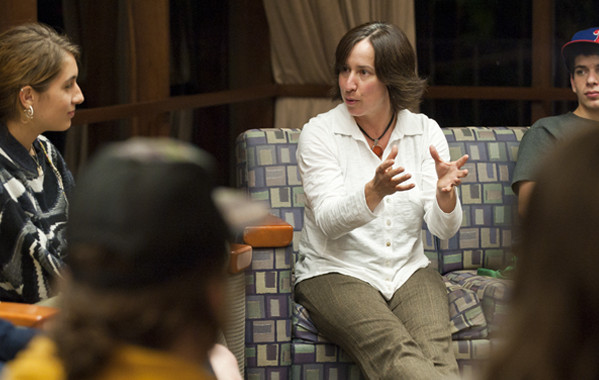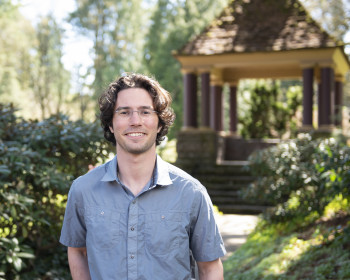Don’t Fear the Pholcid

You’ve probably heard the urban legend: Daddy long-leg spiders possess extremely toxic venom—so toxic that it would kill a human if only their fangs were long/strong enough to penetrate human skin.
After more than a decade of research, Professor of Biology Greta Binford and Research Associate and Visiting Professor Pamela Zobel-Thropp have discovered for the first time what is in the venom of these animals, and compiled evidence of the effects of their venoms on humans. The new evidence crushes that old urban legend.
In a new research paper just published in the journal Frontiers in Evolution and Ecology, Binford and Zobel-Thropp detail their chemical analysis of pholcid (commonly known as cellar spiders or daddy long-legs) venom. Their results show that the venom is full of interesting proteins and peptides and is highly toxic to insects, but all evidence indicates it has negligible toxicity on mammals especially when compared with black widow venom, for example. The paper, “Not So Dangerous After All,” is available now via Open Access Online.
In 2014, Discover Network’s hit series MythBusters took the liberty of dispelling the daddy long-leg myth with venom from the same species and overseen by Chuck Kristensen, a coauthor on this work; however, until Binford’s paper was published, there had been no rigorous analysis of what is in the venom of any pholcid spiders.
Funded by a grant from the National Institutes of Health since 2011, the paper details the team’s diligent pursuit of solid evidence. To reach their findings, the team analyzed the composition of venom of one species of pholcid, which contains over 120 different proteins and peptides that contribute to toxicity.
“Rather than fearing daddy long-legs, we are inspired by the potential for discovery of new chemical activities in these venoms,” Binford said. “They represent a cool, little studied and diverse branch of biodiversity from which we have much to learn.”
To accomplish the analysis, the team relied on technologies for high-throughput sequencing and “proteomics”. This work inspired building technology and a support team at Lewis & Clark for high-performance computing.
Thanks to support from Jeremy McWilliams at Lewis & Clark’s Watzek Library Digital Initiatives Office, the team used the college’s HPC cluster (lovingly named BLT for its three servers: bacon, lettuce, and tomato - better together) to crunch data analyzing 9 proteomes and 22 transcriptomes. The use of high-performance computing not only provided otherwise unattainable insights and discoveries, it also proved invaluable in training student-researchers.
“Having hands-on opportunity for our students to use high-performance computing expands their analytical abilities and allows them to be less limited in the scope of questions they can ask and answer,” Binford said. “It also gives us the chance to teach students how to critically evaluate evidence coming from analyses of ‘big data’.”
Her research team included students (both current and since-graduated), collaborators from other higher-education institutions, and even one local high-school student.
“Being a part of Greta’s research team was one of the greatest privileges I have had in my life,” said Jennifer Mullins BA ’12, who now works in healthcare administration in Western Washington. “Coming from an underprivileged background, I always felt as though I was behind my peers at Lewis & Clark. Thus when applying for the coveted position as a Roger’s Fellow in the Binford Lab, I was sure I was the least likely candidate. But Greta picked me and allowed me to continue a project I had started in her lab the semester prior looking into the daddy long-legs venom myth. What floors me is she let me come up with the project on my own and it is crazy for me to think how it has come to fruition.”
Binford is quick to credit all her research collaborators, including paper coauthor Chuck Kristensen, whom she jokingly calls her “venom dealer.” Kristensen operates Spider Pharm, a company in Arizona that maintains myriad spider species colonies and produces venom for research and antivenom production, including the pholcidae species used in Binford’s research.
Binford’s spider research has appeared in The New Yorker, PBS’s NOVA series, NPR’s Science Friday, to name a few. In 2011, she was named Oregon Professor of the Year. An arachnologist and spider-woman through and through, Binford even has a species of spider named for her (the Austrarchaea binfordae).
Mullins said, “There are many moments that stood out in my experience working with the Binford research team—sailing in the Caribbean catching arachnids, education outreach to Dominican orphans and Haitian refugees—but what made the biggest impact on my life is just having Greta give me the chance to be part of the team. Having someone believe in you makes all the difference.”
More Newsroom Stories
Public Relations is located in McAfee on the Undergraduate Campus.
MSC: 19
email public@lclark.edu
voice 503-768-7970
Public Relations
Lewis & Clark
615 S. Palatine Hill Road MSC 19
Portland OR 97219

